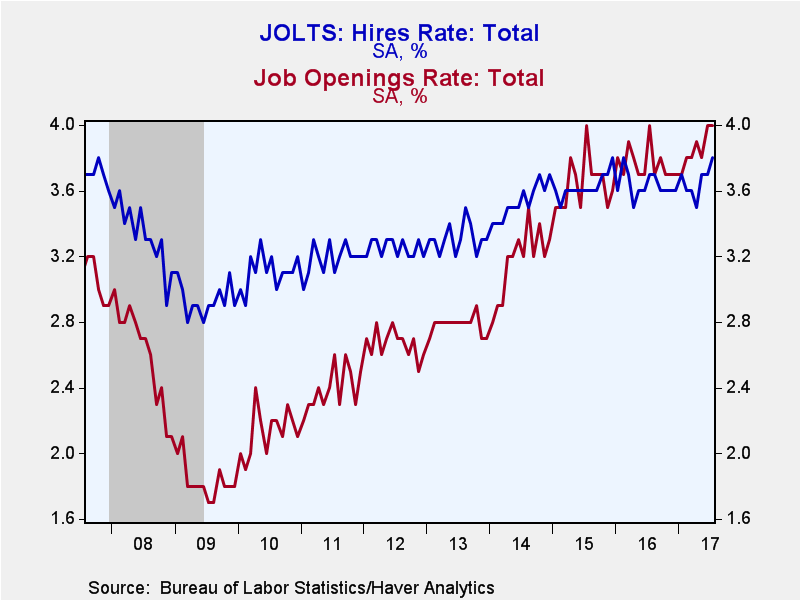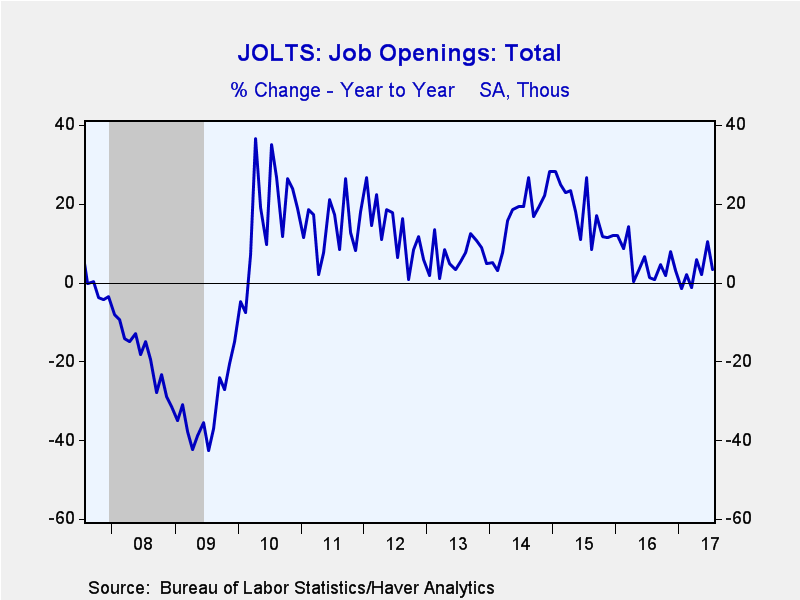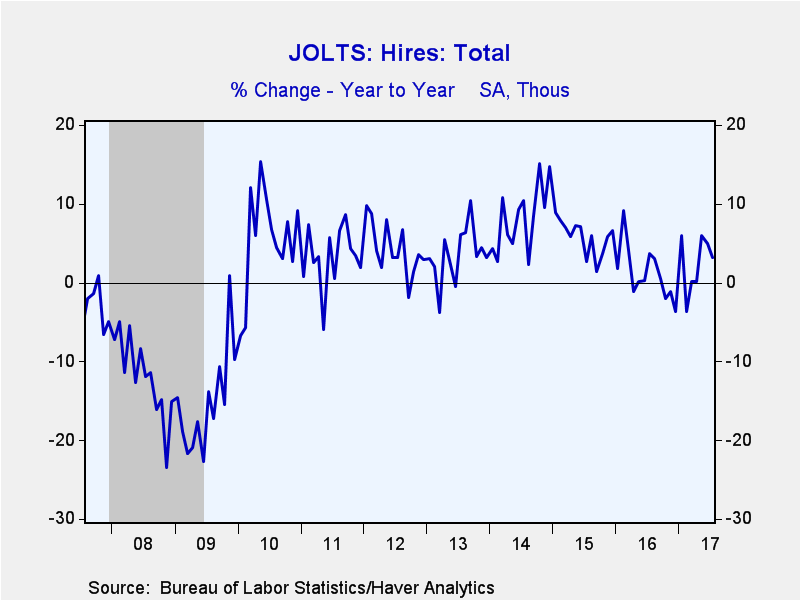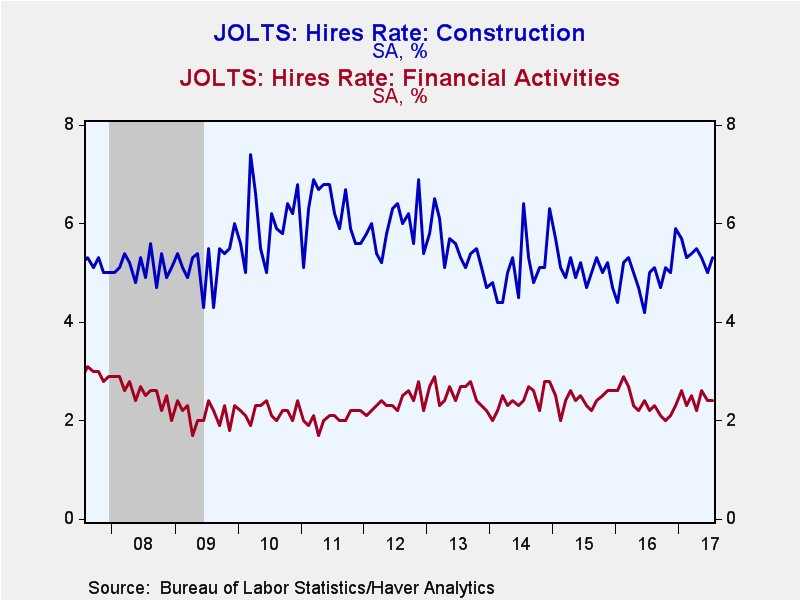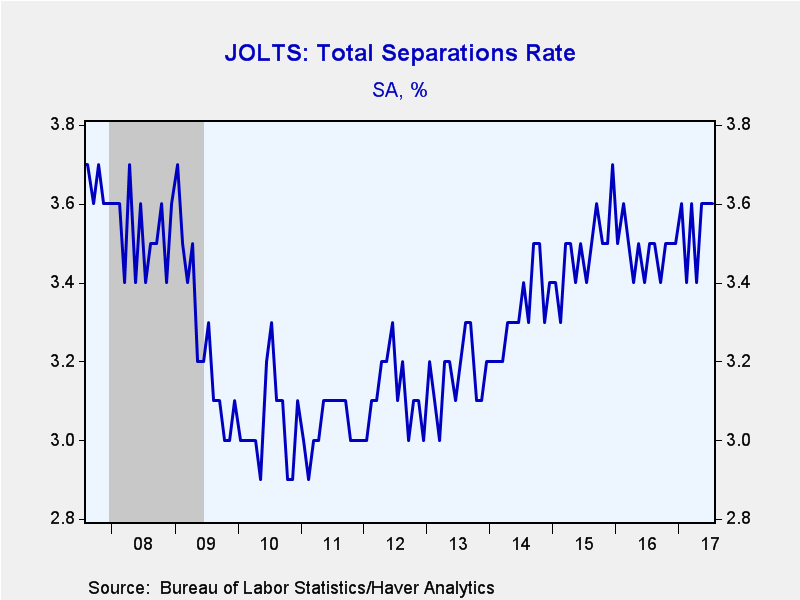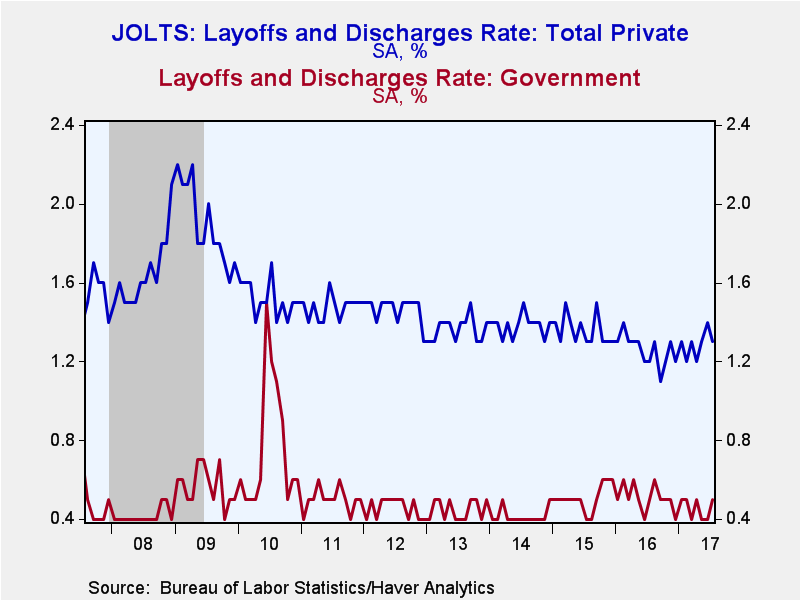 Global| Sep 12 2017
Global| Sep 12 2017U.S. JOLTS: Job Openings Rate Remains at Record High; Hiring Improves
by:Tom Moeller
|in:Economy in Brief
Summary
The Bureau of Labor Statistics reported that the total job openings rate held at 4.0% during July following June's unrevised improvement from 3.8% in May. It continued to equal the record. The hiring rate increased to 3.8%, its [...]
The Bureau of Labor Statistics reported that the total job openings rate held at 4.0% during July following June's unrevised improvement from 3.8% in May. It continued to equal the record. The hiring rate increased to 3.8%, its highest level since February 2016. These figures are from the Job Openings & Labor Turnover Survey (JOLTS) and date back to December 2000.
The private-sector job openings rate strengthened to a record 4.4%. The job openings rate in the leisure & hospitality sector rose to 5.1%, just below the 2001 high. The trade, transportation & utilities rate also surged to 3.8%, but retail trade rose just slightly to 3.8%, down from the record high of 4.0%. The professional and business services openings rate fell m/m to 5.1%, well below its 6.1% high in March of last year. The education & health services rate slipped to 4.8%, up y/y from 4.6%. The construction sector job openings rate surged to 3.2% from 2.0% six months earlier. The factory sector job openings rate eased to 3.0% from June's record high of 3.3%. The government sector rate fell sharply to 2.2%.That was down from June's seven-year high of 2.5%. The job openings rate is the number of job openings on the last business day of the month as a percent of total employment plus job openings.
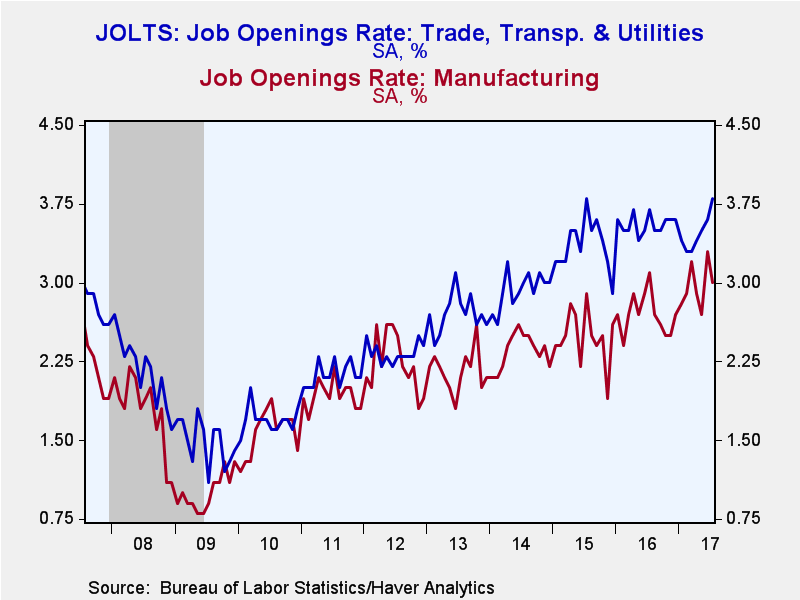 The actual number of job openings increased 0.9% to a record
6.170 million, up 3.3% y/y. Private-sector job openings rose 2.0% (4.4% y/y) to
a record 5.657 million led by a 9.4% jump (-2.5% y/y) in the construction
sector. That retraced a portion of June's strong increase. Trade, transportation
and utilities rose 5.1% (3.2% y/y), but retail trade openings rose just 1.6%
(-0.2% y/y. Leisure & hospitality openings rose 4.8% (12.9% y/y) but
education & health services openings declined 3.9% (+6.0% y/y). Factory
sector openings declined 6.9% (-1.0% y/y), but remained in the recovery's
strengthening mode, while professional & business services openings declined
4.7% (-11.8% y/y). Job postings in the public sector declined 10.2% (-7.7% y/y),
though their up-trend remained in place.
The actual number of job openings increased 0.9% to a record
6.170 million, up 3.3% y/y. Private-sector job openings rose 2.0% (4.4% y/y) to
a record 5.657 million led by a 9.4% jump (-2.5% y/y) in the construction
sector. That retraced a portion of June's strong increase. Trade, transportation
and utilities rose 5.1% (3.2% y/y), but retail trade openings rose just 1.6%
(-0.2% y/y. Leisure & hospitality openings rose 4.8% (12.9% y/y) but
education & health services openings declined 3.9% (+6.0% y/y). Factory
sector openings declined 6.9% (-1.0% y/y), but remained in the recovery's
strengthening mode, while professional & business services openings declined
4.7% (-11.8% y/y). Job postings in the public sector declined 10.2% (-7.7% y/y),
though their up-trend remained in place.
Improvement in the overall hires rate reflected a rise in the private sector rate to 4.2%. That was the highest level since February 2016. The hiring rate in professional & business services held steady at a one-year high of 5.8%. The hiring rate in leisure & hospitality eased to 6.3%. The construction sector hiring rate jumped to 5.3% and recovered its June decline, while the hires rate in the education & health services sector improved to 2.9%. The trade, transportation & utilities rate fell to 3.7% and remained in this year's down-trend. The manufacturing hires rate rose to its recovery high of 2.7%. The government sector hiring rate held steady at 1.5%, down from 1.7% one year earlier.
The total number of hires increased 1.3% (3.2% y/y) to an eleven-year high of 5.501 million. The number of private-sector hires rose 1.2% (4.4% y/y) to an expansion high of 5.164 million. Construction sector hiring jumped 6.1% (9.3% y/y) while factory sector hiring strengthened 5.2% (20.1% y/y) to an expansion high. Hiring in education & health services jumped 4.5% (5.7% y/y) and neared the record. Professional & business service sector hiring gained 1.8% (1.1% y/y) to a record 1.213 million. Hiring in trade, transportation & utilities eased 2.9% (-1.1% y/y) and reversed two months of increase, while the number of leisure & hospitality jobs eased 0.7% (-0.8% y/y). Government sector employment improved 2.1% (-11.3% y/y).
The total job separations rate held steady at 3.6% for a third month. The leisure & hospitality separations rate remained at 6.1%, though that was down from last year's 6.6% high. The construction sector's separations rate increased to 5.4%. The professional and business services rate eased to 5.6%, up from February's 4.9% low. In trade, transportation & utilities, the separations rate slipped to 3.7%. The information sector's rate rebounded to 2.8% from its seven-month low of 2.4% in June. The factory sector separations rate rose slightly to 2.6%, while the separations rate in the financial sector was steady at 2.4%. The separations rate in the government sector was stable at 1.4%, equaling the lowest level since May 2015. Separations include quits, layoffs, discharges, and other separations as well as retirements.
The layoff and discharge rate held at 1.2%, the highest level since May of last year. That was higher than the 1.0% low nine months earlier. The private-sector rate eased to 1.3% and remained below the 2015 high of 1.5%. The government sector rate at 0.5% remained near the recovery low. Total layoffs increased 10.8% y/y. Private-sector layoffs increased 11.8% y/y, while government layoffs rose 6.9% y/y.
Large numbers of hires and separations occur every month throughout the business cycle. Net employment change results from the relationship between hires and separations. When the number of hires exceeds the number of separations, employment rises, even if the hires level is steady or declining. Conversely, when the number of hires is less than the number of separations, employment declines, even if the hires level is steady or rising. These totals include workers who may have been hired and separated more than once during the year.
The JOLTS survey dates to December 2000 and the figures are available in Haver's USECON database.
| JOLTS (Job Openings & Labor Turnover Survey, SA) | Jul | Jun | May | Jul '16 | 2016 | 2015 | 2014 |
|---|---|---|---|---|---|---|---|
| Job Openings, Total | |||||||
| Rate (%) | 4.0 | 4.0 | 3.8 | 4.0 | 3.7 | 3.6 | 3.3 |
| Total (000s) | 6,170 | 6,116 | 5,702 | 3.3% | 3.1% | 12.1% | 28.1% |
| Hires, Total | |||||||
| Rate (%) | 3.8 | 3.7 | 3.7 | 3.7 | 43.6 | 43.5 | 42.4 |
| Total (000s) | 5,501 | 5,432 | 5,459 | 3.2% | 1.2% | 5.8% | 8.2% |
| Layoffs & Discharges, Total | |||||||
| Rate (%) | 1.2 | 1.2 | 1.1 | 1.1 | 13.7 | 14.8 | 14.7 |
| Total (000s) | 1,783 | 1,806 | 1,673 | 10.8% | -4.8% | 2.8% | 2.3% |
Tom Moeller
AuthorMore in Author Profile »Prior to joining Haver Analytics in 2000, Mr. Moeller worked as the Economist at Chancellor Capital Management from 1985 to 1999. There, he developed comprehensive economic forecasts and interpreted economic data for equity and fixed income portfolio managers. Also at Chancellor, Mr. Moeller worked as an equity analyst and was responsible for researching and rating companies in the economically sensitive automobile and housing industries for investment in Chancellor’s equity portfolio. Prior to joining Chancellor, Mr. Moeller was an Economist at Citibank from 1979 to 1984. He also analyzed pricing behavior in the metals industry for the Council on Wage and Price Stability in Washington, D.C. In 1999, Mr. Moeller received the award for most accurate forecast from the Forecasters' Club of New York. From 1990 to 1992 he was President of the New York Association for Business Economists. Mr. Moeller earned an M.B.A. in Finance from Fordham University, where he graduated in 1987. He holds a Bachelor of Arts in Economics from George Washington University.


